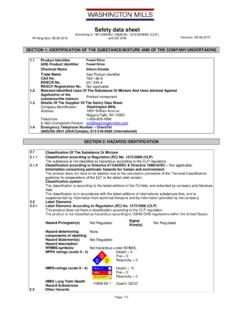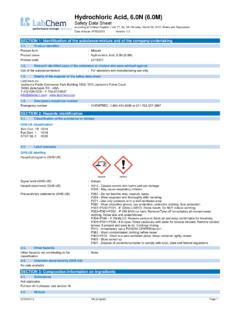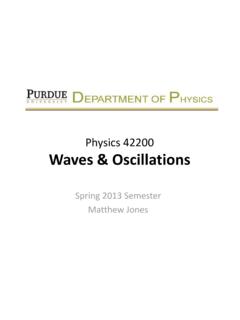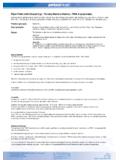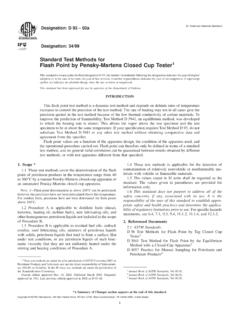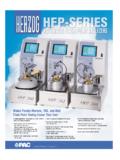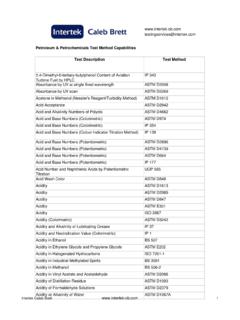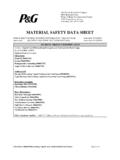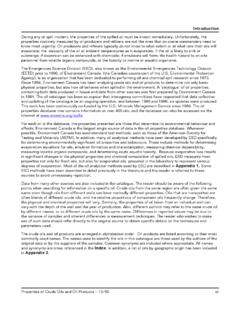Transcription of ITW Devcon Product Code : 10110 PUTTY …
1 MSDS NameDEVCON Plastic Steel PUTTY (A)Manufacturer NameITW DevconStock No.: 10110 Kit MSDS Revision Date1/15/2011 Components PLASTIC STEEL PUTTY (A) RESIN PUTTY HARDENER 0200 ITW Devcon Product code : 10110 SECTION 1 - Product AND COMPANY IDENTIFICATIONP roduct Name:PLASTIC STEEL PUTTY (A) RESINM anufacturer Name:ITW DevconAddress:30 Endicott StreetDanvers, MA 01923 General Phone Number:(978) 777-1100 Emergency PhoneNumber:(800) 424-9300 CHEMTREC:For emergencies in the US, call CHEMTREC: 800-424-9300 Canutec:In Canada, call CANUTEC: (613) 996-6666 (call collect)MSDS Revision Date:1/15/2011 HMISH ealth Hazard 2*Fire Hazard 1 Reactivity 1 PersonalProtection x* Chronic HealthEffectsSECTION 2 - COMPOSITION/INFORMATION ON INGREDIENTSC hemical NameCAS#Ingredient PercentIron7439-89-6 30 - 60 by weightTitanium7440-32-6 1 - 5 by weightBisphenol A diglycidyl ether resin25068-38-6 10 - 30 by weightSilicon7440-21-3 10 - 30 by weightNon-hazardous 1 - 5 by weightFillersN/A 1 - 5 by weightSECTION 3 - HAZARDS IDENTIFICATIONE mergency Overview:WARNING!
2 Potential Sensitizer. of Exposure:Eyes. Skin. Inhalation. Health Effects: Eye:Can cause moderate irritation, burning sensation, tearing, redness, andswelling. Overexposure may cause lacrimation, conjunctivitis, cornealdamage and permanent Skin:Can cause skin irritation; itching, redness, rashes, hives, burning, andswelling. Allergic reactions are cause skin sensitization, an allergic reaction, which becomes evidenton reexposure to this material. Inhalation:Respiratory tract irritant. High concentration may cause dizziness,headache, and anesthetic effects. May cause respiratory sensitizationwith asthma-like symptoms in susceptible individuals. Ingestion:Causes irritation, a burning sensation of the mouth, throat andgastrointestinal tract and abdominal Health Effects:Prolonged skin contact may lead to burning associated with severereddening, swelling, and possible tissue :Overexposure can cause headaches, dizziness, nausea, and Organs:Eyes.
3 Skin. Respiratory system. Digestive of Pre-ExistingConditions:Individuals with pre-existing skin disorders, asthma, allergies or knownsensitization may be more susceptible to the effects of this 4 - FIRST AID MEASURESEye Contact:Immediately flush eyes with plenty of water for at least 15 to 20 adequate flushing of the eyes by separating the eyelids withfingers. Get immediate medical Contact:Immediately wash skin with plenty of soap and water for 15 to 20minutes, while removing contaminated clothing and shoes. Get medical attention if irritation develops or by :If inhaled, remove to fresh air. If not breathing, give artificial respirationor give oxygen by trained personnel. Seek immediate medical :If swallowed, do NOT induce vomiting. Call a physician or poison controlcenter immediately. Never give anything by mouth to an 5 - FIRE FIGHTING MEASURESF lash Point:>400 F ( C)Flash Point Method:Pensky-Martens Closed CupAuto Ignition Temperature:Not Flammable/ExplosiveLimit:Not Flammable/ExplosiveLimit:Not Fighting Instructions:Evacuate area of unprotected personnel.
4 Use cold water spray to cool fireexposed containers to minimize risk of rupture. Do not enter confinedfire space without full protective gear. If possible, contain fire Media:Use carbon dioxide (CO2) or dry chemical when fighting fires involvingthis Media:Water or foam may cause Equipment:As in any fire, wear Self-Contained Breathing Apparatus (SCBA),MSHA/NIOSH (approved or equivalent) and full protective Fire Hazards:Sealed containers at elevated temperatures may rupture explosively andspread fire due to Heating above 300 deg F in thepresence of air may cause slow oxidative decomposition and above 500deg F may cause 6 - ACCIDENTAL RELEASE MEASURESS pill Cleanup Measures:Absorb spill with inert material (e,g., dry sand or earth), then place in achemical waste container. Provide ventilation. Clean up spills immediatelyobserving precautions in the protective equipment section. After removal,flush spill area with soap and water to remove trace personal contact and breathing vapors or mists.
5 Ventilate area. Useproper personal protective equipment as listed in section Precautions:Evacuate area and keep unnecessary and unprotected personnel fromentering the spill Precautions:Avoid runoff into storm sewers, ditches, and Precautions:Pump or shovel to storage/salvage 7 - HANDLING and STORAGEH andling:Use with adequate ventilation. Avoid breathing vapor, aerosol or :Store in a cool, dry, well ventilated area away from sources of heat andincompatible materials. Keep container tightly closed when not in Handling Procedures:Provide appropriate ventilation/respiratory protection againstdecomposition products (see Section 10) during welding/flame cuttingoperations and to protect against dust during sanding/grinding of Practices:Wash thoroughly after 8 - EXPOSURE CONTROLS, PERSONAL PROTECTION - EXPOSURE GUIDELINESE ngineering Controls:Use appropriate engineering control such as process enclosures, localexhaust ventilation, or other engineering controls to control airbornelevels below recommended exposure limits.
6 Good general ventilationshould be sufficient to control airborne levels. Where such systems arenot effective wear suitable personal protective equipment, which performssatisfactorily and meets OSHA or other recognized standards. Consultwith local procedures for selection, training, inspection and maintenanceof the personal protective Protection:Wear appropriate protective glasses or splash goggles as described by 29 CFR , OSHA eye and face protection regulation, or the Europeanstandard EN Protection Description:Wear appropriate protective gloves and other protective apparel toprevent skin contact. Consult manufacturer's data for permeability Protection:A NIOSH approved air-purifying respirator with an organic vapor cartridgeor canister may be permissible under certain circumstances whereairborne concentrations are expected to exceed exposure provided by air purifying respirators is limited. Use a positivepressure air supplied respirator if there is any potential for anuncontrolled release, exposure levels are not known, or any othercircumstances where air purifying respirators may not provide Protective:Facilities storing or utilizing this material should be equipped with aneyewash and a deluge shower safety station.
7 EXPOSURE GUIDELINES Silicon:Guideline ACGIH:Guideline OSHA:15 mg/m3 PEL-TWA: 15 mg/m3 Total particulate/dust (T)converted by : 5 mg/m3 Respirable fraction (R)Notes :Only established PEL and TLV values for the ingredients are 9 - PHYSICAL and CHEMICAL PROPERTIESP hysical State :dark :slight odorBoiling Point:>500 F (260 C)Melting Point:Not :negligibleVapor Density:>1 (air = 1)Vapor mmHg @171 FPercent Volatile:0 Evaporation Rate:<<1 (butyl acetate = 1) Formula:MixtureMolecular Weight:MixtureFlash Point:>400 F ( C)Flash Point Method:Pensky-Martens Closed CupAuto Ignition Temperature:Not Content:0 g/LPercent Solids by Weight100 SECTION 10 - STABILITY and REACTIVITYC hemical Stability:Stable under normal temperatures and Polymerization:Not to Avoid:Extreme heat, sparks, and open flame. Incompatible materials, oxidizersand oxidizing conditions. Heating resin above 300 F in the presence of airmay cause slow oxidative Materials:Strong Lewis or mineral acids, strong oxidizing agents, strong mineraland organic bases (especially primary and secondary aliphatic amines).
8 SECTION 11 - TOXICOLOGICAL INFORMATIONIron:RTECS Number:NO4565500 Ingestion:Oral - Rat LD50: 30 gm/kg [Nutritional and Gross Metabolic - Weight lossor decreased weight gain]RTECS Number:XR1700000 Bisphenol A diglycidyl ether resin:RTECS Number:SL6480000 Skin:Administration onto the skin - Rat LD : >2 gm/kg [Nutritional and GrossMetabolic - Other changes]Silicon:RTECS Number:VW0400000 Eye:Eye - Rabbit Standard Draize test.: 3 mgIngestion:Oral - Rat LD50: 3160 mg/kg [Details of toxic effects not reported otherthan lethal dose value]SECTION 12 - ECOLOGICAL INFORMATIONE cotoxicity:No ecotoxicity data was found for the Fate:No environmental information found for this 13 - DISPOSAL CONSIDERATIONSW aste Disposal:Consult with the US EPA Guidelines listed in 40 CFR Part for theclassifications of hazardous waste prior to disposal. Furthermore, consultwith your state and local waste requirements or guidelines, if applicable,to ensure compliance.
9 Arrange disposal in accordance to the EPA and/orstate and local 14 - TRANSPORT INFORMATIONDOT Shipping Name:Non UN Number:N/ADOT Hazard Class:Not Packing Group:Not by 15 - REGULATORY INFORMATIONIron :TSCA Inventory Status:ListedCanada DSL:ListedTitanium :TSCA Inventory Status:ListedCanada DSL:ListedBisphenol A diglycidyl ether resin :TSCA Inventory Status:ListedCanada DSL:ListedSilicon :TSCA Inventory Status:ListedMassachussetts:ListedPennsy lvania:ListedCanada DSL:ListedCanadian Hazard Class(es): D2 BAll components of this Product are on the Canadian Domestic 16 - ADDITIONAL INFORMATIONHMIS Fire Hazard:1 HMIS Health Hazard:2*HMIS Reactivity:1 HMIS Personal Protection:xMSDS Revision Date:1/15/2011 MSDS Author:Actio CorporationDisclaimer:This Health and Safety Information is correct to the best of ourknowledge and belief at the date of its publication but we cannot acceptliability for any loss, injury or damage which may result from its use.
10 Theinformation given in the Data Sheet is designed only as a guidance forsafe handling, storage and the use of the substance. It is not aspecification nor does it guarantee any specific properties. All chemicalsshould be handled only by competent personnel, within a controlledenvironment. Copyright 1996-2011 Actio Software Corporation. All Rights 1 - Product AND COMPANY IDENTIFICATIONP roduct Name: PUTTY HARDENER 0200 Manufacturer Name:ITW DevconAddress:30 Endicott StreetDanvers, MA 01923 General Phone Number:(978) 777-1100 Emergency PhoneNumber:(800) 424-9300 CHEMTREC:For emergencies in the US, call CHEMTREC: 800-424-9300 Canutec:In Canada, call CANUTEC: (613) 996-6666 (call collect)MSDS Revision Date:1/15/2011 HMISH ealth Hazard 3*Fire Hazard 1 Reactivity 1 PersonalProtection x* Chronic HealthEffectsSECTION 2 - COMPOSITION/INFORMATION ON INGREDIENTSC hemical NameCAS#Ingredient PercentInert materialN/A 5 - 10 by weightNonylphenol25154-52-3 5 - 10 by weightAminoethylpiperazine140-31-8 5 - 10 by weightDimer/TOFA, reaction products with TETA68082-29-1 30 - 60 by weightTriethylenetetramine112-24-3 30 - 60 by weightSECTION 3 - HAZARDS IDENTIFICATIONE mergency Overview:WARNING!


